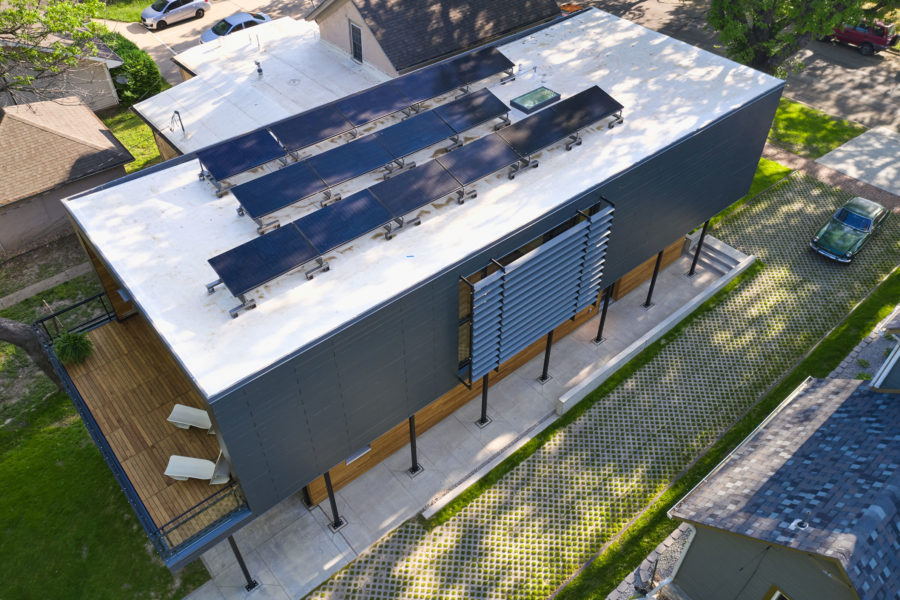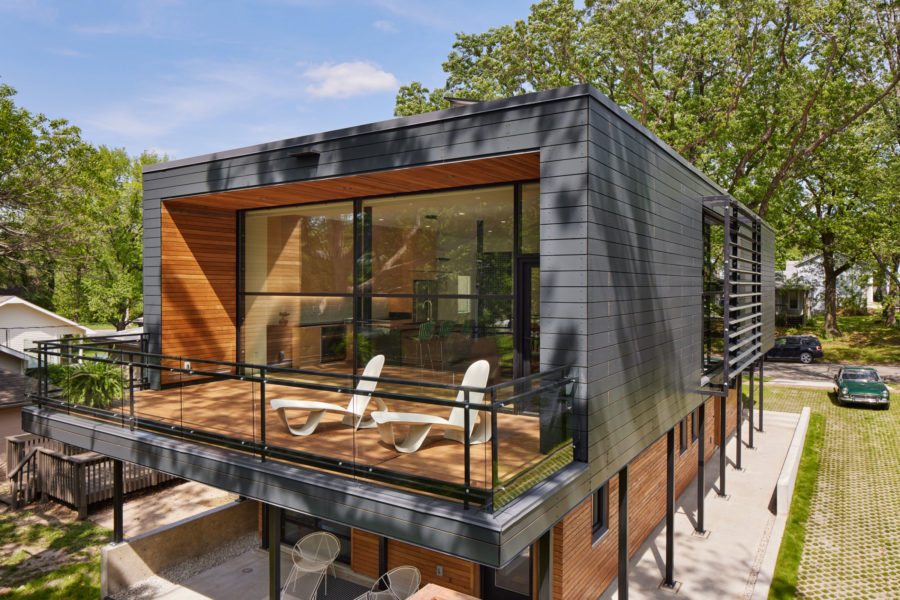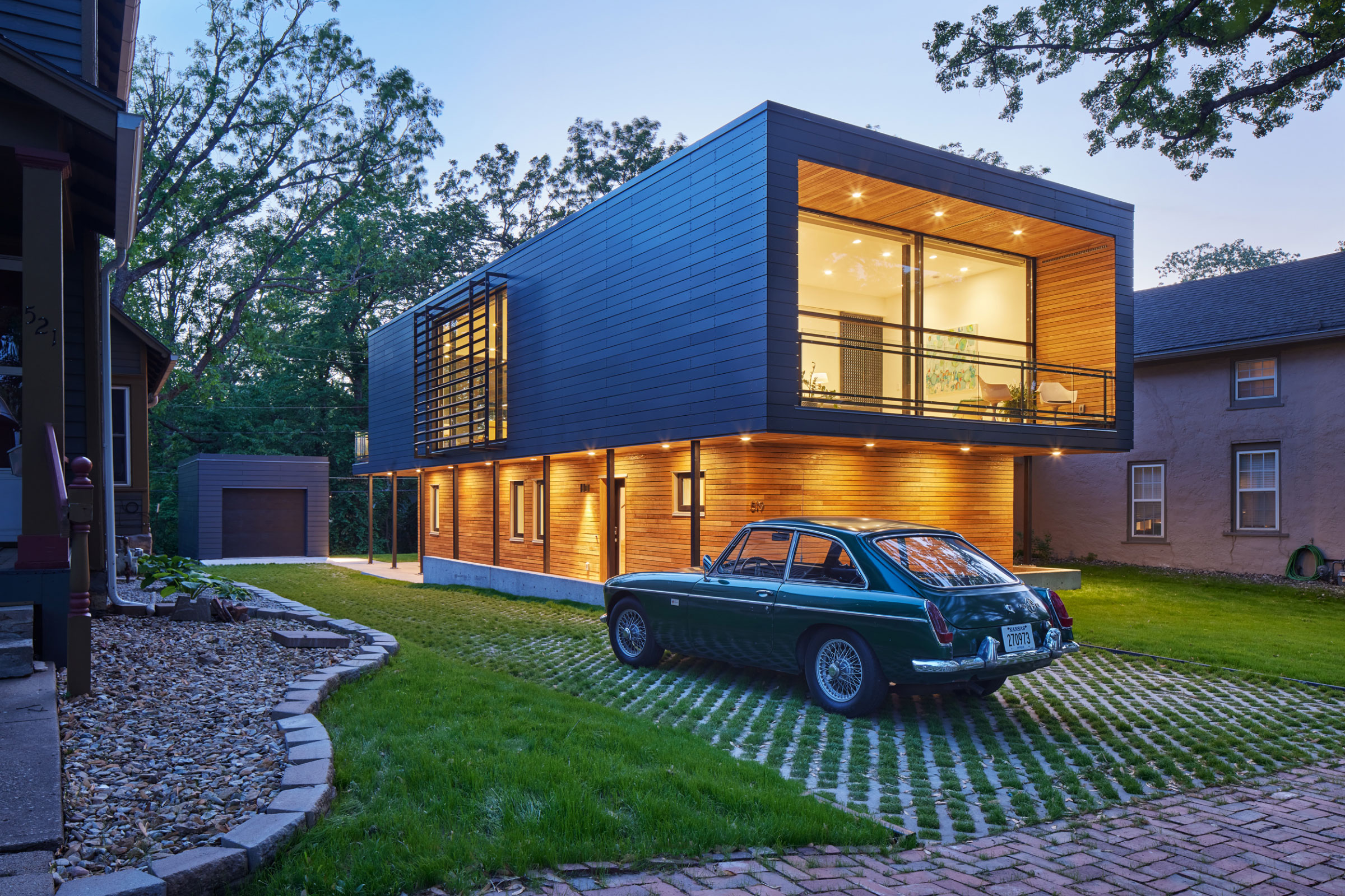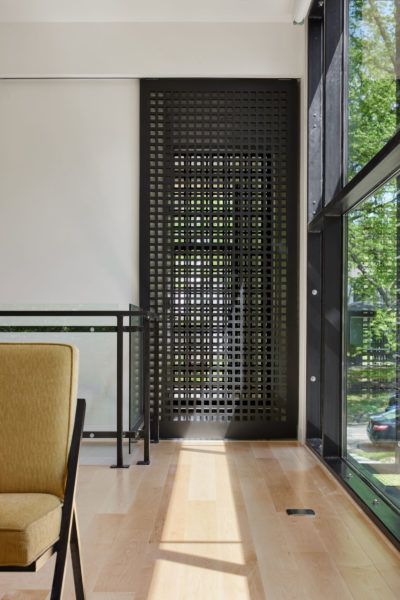Story at a glance:
- The University of Kansas School of Architecture & Design gives students hands-on training.
- As part of the program, students design and build sustainable projects, like this house in Kansas.
The Indiana Street House sits on a small lot in the Pinkney Neighborhood of Lawrence, Kansas. Designed and built by Studio 804, the project is not only a modern, sustainable residence but also an incubator for future advocates of sustainable design.
Studio 804 is a nonprofit comprised of graduate students at the University of Kansas School of Architecture & Design. Each year a new group of participants works alongside Professor Dan Rockhill for two semesters to learn affordable, sustainable, and innovative building solutions. Rockhill has led the program for 25 years and completed more than 14 LEED Platinum projects, one LEED Gold building, and three Passive House projects. “Universities are all about ideas,” Rockhill says. “Studio 804’s big idea is putting the environment front and center. I wish more schools did this.”
Twenty-seven students were part of the Indiana Street House project from start to finish, blueprints to construction. When they began work in August 2021, their design was informed not only by a focus on sustainability but also by the site’s narrow 50-foot infill lot. “The neighbors built over 100 years ago, before zoning restrictions were implemented, so the property was really pinched by today’s standards,” Rockhill says. “The site was overgrown for a long time, as if everyone was wondering if a building could even fit there.”
The house to the north reaches the property line, and the house to the south is just two feet off the property line. As a result, the Studio 804 team made the first floor slimmer in profile to allow it to fit nicely with its surroundings while still offering outdoor space. For additional panache, the grade drops 11 feet from front to back, making it look like the foundation is emerging from the landscape. The ground floor features two bedrooms, a full bathroom, and a mechanical room.

Inside the Indiana Street House, designed by Studio 804. Photo by Gaffer Photography
The main bedroom and an expansive living room are on the second floor, which sits on 22 steel columns. This elevates them above the landscape and provides more exposure to daylight and expansive views via the large windows at either end of the home. A cantilevered deck sits off the bedroom on the east, with another deck on the west accessible from the living room. “Architecturally I love the proportions and the way they dealt with the site issues,” Rockhill says.
As with all Studio 804 projects, sustainability was top of mind. All exterior walls are insulated well beyond code to restrict heat flow, with a final R-value of 41.45. The HVAC system includes energy recovery ventilation (ERV), which exhausts stale interior air while using it to warm the incoming fresh air. There are also overhangs, custom louvers, sunscreens, and high-performance glazing in place to help ensure the building doesn’t overheat during the summer.

The roof mounted solar array is comprised of 15 high-wattage Q-cells, supporting a 6-kWh system and producing 9,377 kWh’s annually. Photo by Gaffer Photography
A solar array comprised of photovoltaic cells is mounted on the building’s roof, capable of offsetting approximately 80% of the average Kansas home’s energy consumption. And the garage is covered with a green roof of sedums to reduce the stormwater runoff.
A lot of reclaimed materials were used throughout construction as well. The primary siding on the second level is a phenolic, high-pressure laminate that is a byproduct of lumber production at sawmills. The project used nearly 85 yards of concrete and approximately 20% of each yard was comprised of fly ash—a byproduct of the combustion of coal burning plants. The majority of glass used on the project was repurposed, as it was purchased from a builder who had originally intended it for another project that was never built.
- The black perforated sliding screens in the interior of the home were fabricated by students in the Studio 804 shop from Richlite, which is made of post-consumer recycled paper. Photo by Gaffer Photography
- The decking, walls, soffits, and lower-level siding are made of sassafras—a domestic hardwood native to the eastern US. The upper-level siding is the matte black Fundermax—a lumber production byproduct developed in Austria that is extremely moisture-, weather-, fire-, and UV-resistant. Photo by Gaffer Photography
Even the driveway was designed with the environment in mind, using pavers made of concrete with voids between them to let the grass grow through. Below the pavers is a subassembly of sand, compacted layers of aggregate, and a heavy geotextile fabric to control weeds and create a reservoir for stormwater runoff. Rockhill notes that this required them to jump through a lot of engineering hoops, but it was worth it because it vastly improved the sites permeability. “The new owners really appreciate what they got in terms of sustainability, which is great,” he says. The project meets the standard for LEED Platinum and is in the process of final certification.
Rockhill notes that the work of Studio 804 is intended to be not only functional but also a demonstration of sustainable design, with the goal of teaching not just the students working on them but also the community. To that end, an open house was held in May 2022 during graduation weekend, and approximately 1,000 people visited the site to tour the home. After some prepping and coaching from Rockhill, the students acted as tour guides and answered questions from visitors.

Photo by Gaffer Photography
All 27 students who worked on the Indiana Street House have graduated from the University of Kansas School of Architecture & Design. “These students represent the future of sustainable design and construction,” Rockhill says. “Maybe the old guard in this field won’t change; it might be up to the young people to push for it. The more people I can support and teach, the better it is for the future.”





